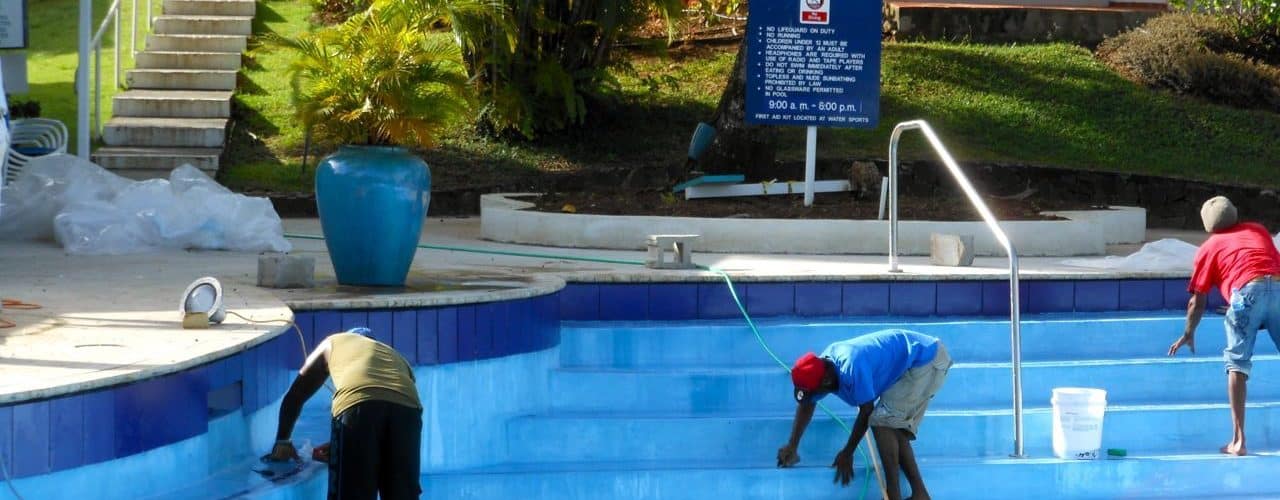It is often perceived that the maintenance of a swimming pool is an intimidating process, and a great deal of work, so many people would not venture to get a pool or if they do, they will hire out the maintenance of it to professionals. You will miss out on the joys of owning a pool or you will waste a lot of money in hiring a maintenance person to do something you can easily manage yourself; maintaining the swimming pool is easier than think.
Here are simple steps to keep the pool clean and free of germs:
• This first step is very basic – keep the pool covered! This will take a little extra time to do, but will keep out dirt and debris from the pool, and will make it unnecessary to clean these things out when you do not have to. The water will remain clear because those unseen elements like bacteria and dirt are not present and you will save on both money and chemical treatments.
• Invest in a water testing kit. The complexities of these kits vary from a simple dipstick that will test basic chemicals to the more complex kits that will require mixing. Use these kits to weekly test the water. You also have the option of getting the water analyzed at a pool store free of charge usually.
• Maintain the chemicals in the water at the good level, and this will entail keeping the PH and chlorine concentration at just the right levels which in turn make the pool water much less irritating to your eyes and skin and will prevent algae from growing. Chlorine is added to the water to prevent accumulation of organisms which causes sickness. Applying (or dumping) the chlorine incorrectly, will make its addition ineffective. To properly add chlorine, you place chlorine sticks or tablets into the distribution or filtering system. Also you could install a floating or automatic chlorine feeder to the pool.
• Maintain the water’s PH, or base or acidity levels. The PH level should be maintained at 7.2 – 7.6. If the PH is too acidic (greater than 7.6) pool corrosion can occur, and also anything that is directly connected to it. If the PH level is too basic (PH less than 7.2), the growth of organisms will be encouraged in the water. PH levels should be checked weekly. The PH levels will be maintained if alkaline substances are dissolved at a level of 80 – 150 ppm (part per million). The lower the alkalinity the lower the PH and vice versa.
• Vacuum the pool weekly and remove all debris as soon as possible. Although the debris in the pool does not affect the water quality, it will clog the filter. Debris can scratch the liner of above the ground pools.
• Scrub the pool walls when needed. Often people add chemicals and vacuum the pools, but they neglect to clean the pool walls. If the walls are not regularly scrubbed, dirt and algae will quickly accumulate on them. A good time to scrub the walls will be when you are vacuuming the pool, and you can use a runner brush or a sponge for the scrubbing. Use a brush and a vacuum to get to the corners of the pool that are difficult to clean and where the filters cannot reach. Another way to prevent the growth of algae is to use algae inhibitors. This can be purchased in a liquid form at the pool supply store and is put into the intake of the skimmer and will later be pumped into the pool.
• Shock the pool twice weekly to remove bather waste left by pool bathers. Shocker products are also called oxidizers and burners. These shockers are available usually in a powder form and are easy to use by just following the instructions. The process allows then to be distributed across the entire pool, but from below. Be aware that different shockers exist for non-chlorinated and for the chlorinated pools, so be certain to read all labels carefully.
• Add Stabilizers to the pool water to allow the chlorine to last longer. For the proper stabilizing of the pool, be certain that the range of Cyanuric acid in the pool is 30 – 50 ppm. At that range the chlorine will last about 3 weeks longer. The stabilizer level should be checked every 3 weeks.
• Check the calcium level in the pool every year. Keep this level in the good range of 175 ppm – 225 ppm. Cloudy build up and corrosion will occur if too much calcium is present in the water.
• Check the pool’s pump for excessive noise. If the pump is noisy or older than seven years old, it should be replaced. The newer pumps will be more efficient, but still check them on a regular basis for wear and tear.
• Clean the pool’s filter using the back-flushing technique once a month. Instructions for doing this will be supplied with the pump. While cleaning the filter, be certain to also:
1. Rinse the filters after they show a pressure rise of more than 10lbs
2. Replace its diatomaceous earth filter 2 or 3 times yearly.
3. Replace modern filter cartridge every 2 or 3 years.
4. Replace completely the filter’s sand every 2 or 3 years.
By following these pointers, you will be able to maintain you own swimming pool yourself.



